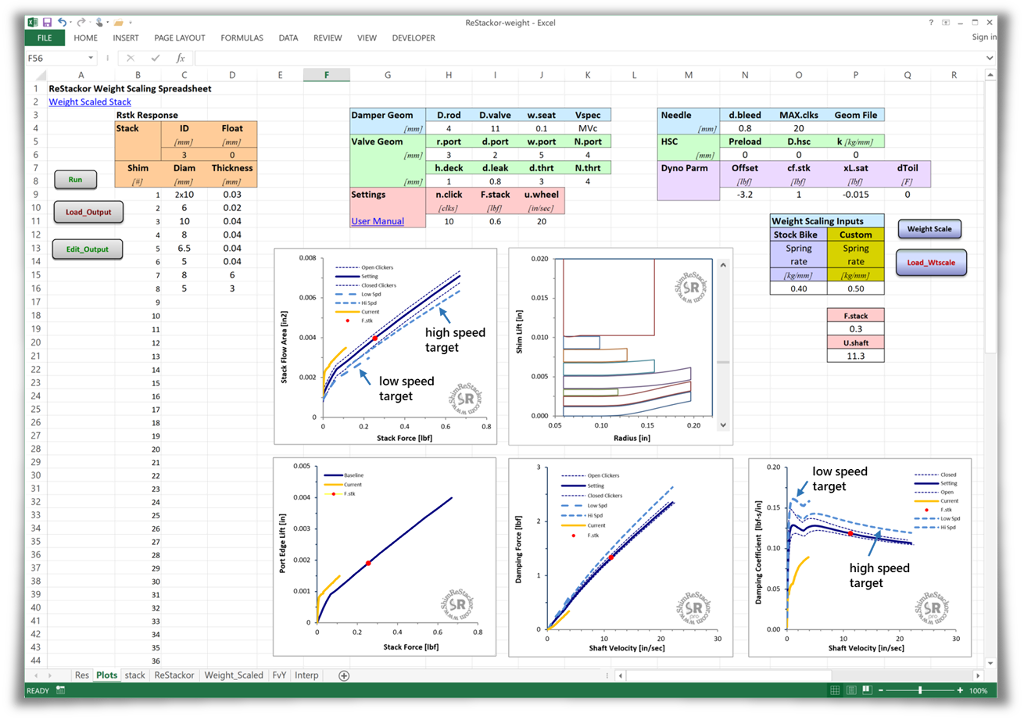Manufactures spend millions perfecting the suspension response, “feel” and behavior of production bikes. Getting it right is good for sales, especially when the magazines rave about the performance.
However, damping of stock suspensions is specific to the spring rate and rider weight the bike was designed for. Changing springs to match rider weight and race sag messes up response of the stock suspension system.
Spring-mass-damper theory defines the specific relationship between spring rate, rider weight, damping and suspension response. Weight scaling suspension systems computes the damping needed to correct suspension response for a change in spring rate and restores the suspension response, “feel” and behavior the manufacturer intended for the setup.
Shim ReStackor spreadsheets make weight scaling easy. Correcting damping for spring rate changes simply requires hacking around on the shim stack configuration to hit the target weight scaled damping curve.

Weight scaling spreadsheet
The single input of spring rate specifies the damping correction needed to scale a known good setup to the spring rate and rider weight of the new spring rate. The weight scaled damping correction specifies two targets: The broad dashed line, shown in the screen shot, specifies the low speed damping needed for chassis control; the thin dashed line shows the high speed damping required for wheel motion control.
Weight scaling the baseline, from stock damping or a custom tuned shock, to a new spring rate simply requires hacking around on the shim stacks to hit the target damping curve.
Shim stack slide bar
The shim stack slide bar on weight scaling spreadsheets pans the shim stack through the deflection range and positions red dots on each curve to show the value at that shim stack deflection.
The slide bar is useful for determining how various shim stack design features, like crossover gaps, effect the damping force curve and the shaft velocity where those features kick in.

Shim stack target tuning
The example below uses the Shim ReStackor demo weight scaling spreadsheet to weight scale stock damping from a 0.4 to 0.5 kg/mm spring rate. The demo is limited to 10 mm valves and shim stacks of 10 shims. The final two entries in the shim stack input must specify the shim stack clamp washer and nut dimension. That limits the “tunable” shims from ten to eight.
To run the weight scaling spreadsheet enter the shock shim stack configuration, the valve port geometry, the stock spring rate and the new spring rate you want to scale to. Hit the “Weight Scale” and “Load_Wtscale” run buttons.
The computed result solid blue line shows the damping force curve of the stock baseline case and the available clicker tuning range. The dashed blue lines show the weight scaled damping targets. Stiffer damping is needed to hit the damping target.
The yellow line shows the current result from hitting the “Run” and “Load_Ouput” buttons. Adding a face shim to the stock stack matches the high speed damping target above 10 in/sec, but low speed damping is too soft.
Hitting the low speed damping target requires modifying the crossover configuration.

Stiffer crossover
Increasing the crossover diameter from 6 to 7 mm matches the low speed damping target. With the stiffer crossover slightly thinner face shims are needed to keep high speed damping on target.
The modified setup is close to the target curve, however damping force rolls-off slightly at high speed. To prevent the high speed roll-off stiffer shims are needed in the stack taper section.

High speed stack tuning
Increasing the thickness of the 6.5 mm shim in the stack taper from 0.04 to 0.042 mm matches the high speed damping target at 20 in/sec. By the thickness cubed rule, the thicker shim increases the stiffness by 15%.
Matching the target damping curve required multiple changes of adding a face shim, a stiffer crossover and a stiffer high speed stack. Stepping through each modification with Shim ReStackor allows fine tuning of each component to obtain the best damping curve match.
Individually, none of those modifications are sufficient. Correcting the damping force curve required multiple simultaneous changes to get the right combination of low and high speed damping.
Trying to figure out those corrections using the “one thing at a time” seat of the pants tuning approach is nearly impossible.

Shim ReStackor weight scaled damping
Spring–mass-damper theory defines the relationship between mass, spring rate and damping needed to correct suspension performance for a spring rate change.
The Shim ReStackor weight scaling spreadsheet makes application of that basic theory easy.
Correcting the damping force curve to get the right combination of low and high speed damping requires multiple simultaneous changes to the face shims, crossover and high speed stack.
Shim ReStackor makes that process easy allowing fine tuning of each component to obtain the best damping force curve shape and fine tune performance far beyond the limits previously possible.

There is no secret formula to determine the shim stack modifications needed to achieve a specific damping force curve. Shim stacks are simply tuned by hacking

